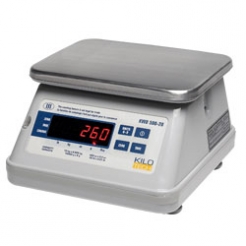
If you have the belief that every scale is the same, you are virtually saying the same thing as every automobile is the exact same or every smartphone is identical. The old expression you get what you pay for applies to anything, warehouse scales included. Therefore, making the decision to cut corners by paying less for a scale is often a grave mistake. Why? It is important to keep in mind that any successful warehouse must have control over the entire process of production and delivery, start to finish. But what happens when you take every necessary precaution, control every single step of the production process efficiently only to get to the point where you weigh and ship your product, and do so inaccurately.
The margin of error with scales is minute. An inaccurate scale will produce minor inaccurate readings yet over the course of weighing a few thousand products every day/week/month you are all of the sudden looking at one major loss of potential income. Consequently, every wise warehouse owner/manager understands that one of the major factors to running a smooth and profitable operation is dependent on the scale(s) which you use.
Accurate Scale = Less on Shipment
Now that you understand a scale is simply not a scale, you are ready to take the next step in finding the one which is appropriate for your operation. The problem is that differentiating one scale from another is not always clear cut. Yet you understand that the margin of error is extremely small because a few decimal points of a difference shoot up the cost of shipping in the long-run. You really cannot afford that mistake in the 21st century.
What makes an accurate scale?
In order to keep operation costs down you need an accurate scale. We have already concluded as much. But what makes an accurate scale? It is a combination of one which is durable, able to withstand the often chaotic nature of a warehouse while also being produced with high-quality materials. Again, you get what you pay for so if you have the option of deciding between a $200 and $500 scale, which one do you think will be more accurate? Of course you can get into the finer details but in this case, as with most, money buys accuracy.
Types of Scales
While all scales perform essentially the same function, they are quite different in terms of how much product they can weigh, how the measurement is calculated, and how they’re built. Like a lot of products, scales are sold in a variety of shapes, sizes, and types. Which one is appropriate for your warehouse depends on individual needs, namely the types and sizes you need to weigh.
Rated Maximum Capacity
Every scale on the market, whether used in your bathroom or at the warehouse has a rated maximum capacity. For warehouse scales, this capacity often soars into the hundreds of pounds, as most warehouses ship out a number of very heavy packages each day. The problem is many warehouse operators make the mistake of buying a scale which meets their ‘typical’ package weight. Now with little margin of error you expose the risk of inaccurate readings. Consequently, if you average weights of 500 pounds look for a scale which is capable of reading at least 120 percent of that amount. The margin of error is not nearly as prone to be a factor in this event.
